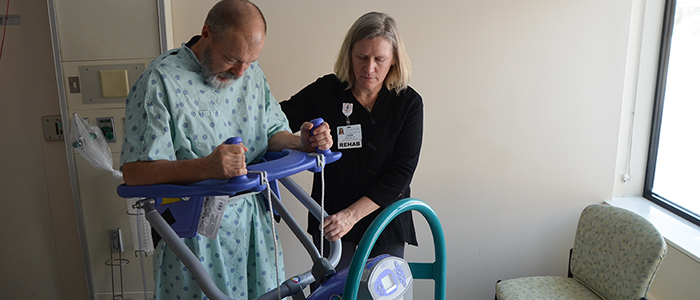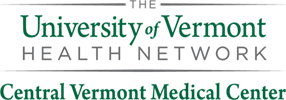
Physical therapist Julie Giffin demonstrates new patient handling equipment, the Sara Plus, which helps patients walk and bear weight safely. The new program to Move All Patients Safely (MAPS) and also reduce workplace injuries is being rolled out over three years at the University of Vermont Health Network- Central Vermont Medical Center.
Berlin, VT – The University of Vermont Health Network – Central Vermont Medical Center has made a significant investment in safe patient handling and mobility which will also reduce staff injuries and improve how we care for our patients. The program named Moving All Patients Safely, or MAPS, addresses a problem that is prevalent in health care facilities across the country – sicker patients and larger patients. Out-patient services have expanded and patients in hospitals are those who are too sick to go through an out-patient department. Obesity is a problem throughout the United States and is reflected in larger people in our patient population.
UVM Health Network – CVMC’s program system includes new patient handling equipment to move patients safely. This includes equipment that helps patients walk and weight bear, move in bed as well as lift and transfer. All patients’ mobility status will be assessed on a regular basis at the medical center and at Woodridge Rehab and Nursing and appropriate equipment will be utilized. The majority of health care accidents in today’s healthcare organizations are related to patient lifting, turning, boosting and moving.
For patients, MAPS improves early mobilization and vital body functions, reduces immobility acquired complications, improves the rate of patient recovery and quality of life, and decreases the length of hospital stay.
Similar programs have delivered on average 84% reduction in the number of patient handling related injuries to health care staff across more than 800 facilities. The average nurse lifts about 1½ tons during a shift. That’s about the weight of a 1969 Volkswagen Beetle and is the reason why we started the MAPS program.
MAPS also improves quality of care by reducing falls, pressure ulcers, skin tears and bruising.
“At UVM Health Network – CVMC, safe patient handling starts when a patient is getting out of the car or when they enter the emergency department or check in at the registration desk,” according to Robert Patterson, vice president of rehabilitation therapy and human resources. “Our program started in October 2014 and has moved throughout the organization from transport staff to radiology, rehabilitation therapy and nurses in all departments. To date we have trained over 400 staff members.”
The MAPS program will be rolled out over three years including capital expenditures on equipment and clinical support at and approximate cost of $500,000. It is estimated that the return on investment will be approximately 18 months.
The University of Vermont Health Network – Central Vermont Medical Center is part of a four-hospital system established to deliver high quality academic medicine to every community we serve. Our partners in The University of Vermont Health Network are Champlain Valley Physicians Hospital, The University of Vermont Medical Center and Elizabethtown Community Hospital.
